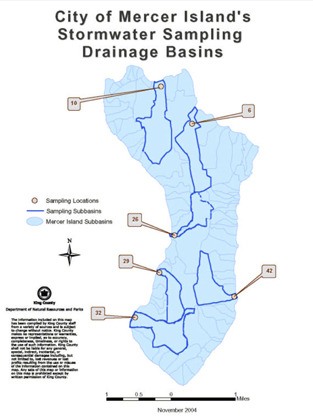If you took the time to read the detailed, data-heavy report about water runoff from Mercer Island, you might be alarmed by the names of toxic chemicals or items such as ‘animal waste,’ listed on nearly every page.
It turns out, however, that the Island’s impact on the water quality of Lake Washington during storms is not too bad.
City Engineer Patrick Yamashita told the Reporter, “Overall, the quality of Mercer Island’s stormwater runoff has some issues typical of small residential communities but not as significant as larger urban cities with impacts from industries and heavy traffic.”
The monitoring is part of the city’s comprehensive stormwater management efforts, explained Yamashita. “It is intended to help us identify trends in stormwater quality in key Mercer Island streams. The report was funded by the stormwater utility.”
The studies cost approximately $70,000, he said.
According to the data, Mercer Island complies with basic state and federal standards for ammonia-nitrogen concentrations, temperature and pH.
Over the course of the 11-year project, the only herbicide or pesticide detected at concentrations above available guidelines was diazinon. Diazinon has been linked to serious human health effects and is often cited in accidental deaths. Diazinon is reportedly highly toxic to birds.
The report points out that there are still things that need to be monitored and addressed:
Insecticide diazinon and compounds found in weed-n-feed products have been detected in the past samples.
Nitrate and phosphate concentrations found in fertilizers and animal wastes have often been higher than the federally recommended levels. Animal waste can include dogs, geese or even humans
Erosion of steep ravines continues to send mud into Lake Washington, causing turbidity levels that exceed state standards during major storms.
Basins 10 and 32 are the Island locations that cause concern. Area 10 includes the Town Center north to the lake between the Lincoln and the 77th Ave S.E. landings. Area 32 in on the southwest end of the Island and encompasses the slope west down S.E. 68th and 70th Streets and South end shopping center. Both areas continue to have high copper and zinc concentrations. Those metals are often seen in runoff from parking lots and roads. Another culprit is uncoated galvanized metal, the engineer said.
Protecting the water quality of the lake is the primary justification for impervious surface limits on new construction. Those limits can be waived or adjusted on occasion by the city if there are mitigating factors.
The results in the present study came from sampling data conducted during Island storms. In the next few years, the city will conduct ongoing monitoring to investigate potential sources of dissolved metals in basins 10 and 32.
While controlling the sources of some substances can be elusive, some very straightforward corrections have been made to control toxic runoff.
Two such examples include a private sewer that was plumbed to the storm drainage system and the remnants of a private underground heating oil tank that was leaching into the drainage system. Both situations have been addressed, Yamashita said.
Full copies of the monitoring program annual reports, including laboratory data, are available for review by contacting Yamashita at 275-7722.


